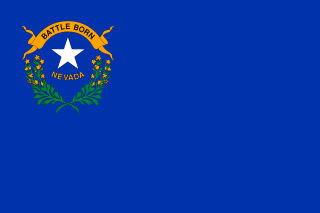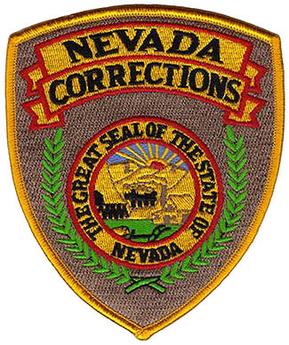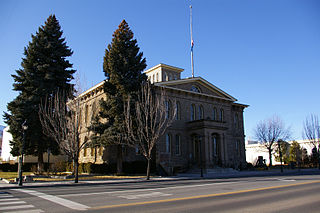Related Research Articles

Carson City is an independent city and the capital of the U.S. state of Nevada. As of the 2020 census, the population was 58,639, making it the 6th most populous city in the state. The majority of the city's population lives in Eagle Valley, on the eastern edge of the Carson Range, a branch of the Sierra Nevada, about 30 miles (50 km) south of Reno. The city is named after the mountain man Kit Carson. The town began as a stopover for California-bound immigrants, but developed into a city with the Comstock Lode, a silver strike in the mountains to the northeast. The city has served as Nevada's capital since statehood in 1864; for much of its history it was a hub for the Virginia and Truckee Railroad, although the tracks were removed in 1950.

Nevada is a state in the Western region of the United States. It borders Oregon to the northwest, Idaho to the northeast, California to the west, Arizona to the southeast, and Utah to the east. Nevada is the 7th-most extensive, the 32nd-most populous, and the 9th-least densely populated of the U.S. states. Nearly three-quarters of Nevada's people live in Clark County, which contains the Las Vegas–Paradise metropolitan area, including three of the state's four largest incorporated cities. Nevada's capital is Carson City. Las Vegas is the largest city in the state.

Las Vegas, often known simply as Vegas, is the most populous city in the U.S. state of Nevada and the county seat of Clark County. The Las Vegas Valley metropolitan area is the largest within the greater Mojave Desert, and second-largest in the Southwestern United States. Las Vegas is an internationally renowned major resort city, known primarily for its gambling, shopping, fine dining, entertainment, and nightlife, with most venues centered on downtown Las Vegas and more to the Las Vegas Strip just outside city limits. The Las Vegas Valley as a whole serves as the leading financial, commercial, and cultural center for Nevada. According to the United States Census Bureau, the city had 641,903 residents in 2020, with a metropolitan population of 2,227,053, making it the 25th-most populous city in the United States.

Henderson is a city in Clark County, Nevada, United States, about 16 miles (26 km) southeast of downtown Las Vegas. It is the 2nd most populous city in Nevada, after Las Vegas, with an estimated population of 320,189 in 2019. The city is part of the Las Vegas Valley. Henderson occupies the southeastern end of the valley, at an elevation of 1,864 feet (568 m).

The Las Vegas Valley is a major metropolitan area in the southern part of the U.S. state of Nevada, and the second largest in the Southwestern United States. The state's largest urban agglomeration, the Las Vegas Metropolitan Statistical Area is coextensive since 2003 with Clark County, Nevada. The Valley is largely defined by the Las Vegas Valley landform, a 600 sq mi (1,600 km2) basin area surrounded by mountains to the north, south, east and west of the metropolitan area. The Valley is home to the three largest incorporated cities in Nevada: Las Vegas, Henderson and North Las Vegas. Eleven unincorporated towns governed by the Clark County government are part of the Las Vegas Township and constitute the largest community in the state of Nevada.

Downtown Las Vegas is the central business district and historic center of Las Vegas, Nevada, United States. It is the original townsite, and the Downtown gaming area was the primary gambling district of Las Vegas prior to the Strip. As the urban core of the Las Vegas Valley, it features a variety of hotel and business highrises, cultural centers, historical buildings and government institutions, as well as residential and retail developments. Downtown is located in the center of the Las Vegas Valley and just north of the Las Vegas Strip, centered on Fremont Street, the Fremont Street Experience and Fremont East. The city defines the area as bounded by I-15 on the west, Washington Avenue on the north, Maryland Parkway on the east and Sahara Avenue on the south.

The Nevada State Railroad Museum Boulder City is a railroad museum in Boulder City, Nevada which is an agency of the Nevada Department of Tourism and Cultural Affairs. The railway is located on the Boulder City Branch Line, the historic railroad route installed to support construction activities at the Hoover Dam. The state obtained the tracks and right of way from the Union Pacific Railroad in 1985.
Clifford Aaron Jones, Sr. was an American politician. He was the 20th lieutenant governor of Nevada from January 1947 to December 1954.

The Nevada Department of Corrections (NDOC) is a governmental agency in the U.S. state of Nevada. The NDOC headquarters is located on the property of the Stewart Indian School in Carson City.

Interstate 15 (I-15) is an Interstate Highway in the U.S. state of Nevada that begins in Primm, continues through Las Vegas and it crosses the border with Arizona in Mesquite. Within the state, the freeway runs entirely in Clark County. The highway was built along the corridor of the older U.S. Route 91 (US 91) and Arrowhead Trail, eventually replacing both of these roads.
The Nevada State Museum, Las Vegas is located on the campus of the Springs Preserve, in Las Vegas, Nevada and is one of seven Nevada State Museums operated by the Nevada Department of Tourism and Cultural Affairs. The name was changed from the Nevada State Museum and Historical Society in 2008 when the museum moved from Lorenzi Park, Las Vegas to the Springs Preserve campus. The museum houses items from the development of Las Vegas as well as the natural history of the area. The museum is open Thursday through Monday, 9 am to 4 pm, closed Thanksgiving and Christmas.
The Nevada Renewable Energy and Energy Efficiency Authority was a state government agency in Nevada charged with promoting energy conservation and use of renewable energy sources. Its administrator held the title of Nevada Energy Commissioner.
The Public Utilities Commission of Nevada supervises and regulates the operation and maintenance of utility services in Nevada. The agency has two headquarters, one in Carson City and one in Las Vegas.

The Nevada State Museum in Carson City is one of seven Nevada State Museums operated by the Nevada Department of Tourism and Cultural Affairs. The primary building of the museum is the former Carson City Mint. The exhibits include:

The Nevada Department of Motor Vehicles (DMV) is a Nevada state agency responsible for issuing driver licenses and vehicle registration. The DMV operates a total of 20 offices across the state, with five in Las Vegas, two in Reno, and one each in Henderson, Sparks, Carson City, Elko, Ely, Fallon, Hawthorne, Laughlin, Mesquite, Pahrump, Tonopah, Winnemucca, and Yerington. The DMV is headed by a director, and the position is currently occupied by Julie Butler. It is based in Carson City, Nevada's capital.
The Nevada Department of Tourism and Cultural Affairs is a state government agency in Nevada that focuses on the promotion and regulation of Nevada's tourism and cultural industries and landmarks.
References
- 1 2 3 Audit Report (PDF) (Report). Nevada Department of Cultural Affairs Director's Office. August 15, 2005. p. 1. Retrieved 2016-06-15.
- ↑ "Chapter 189". 2001 Statutes of Nevada. May 28, 2001. Retrieved 2016-06-15.
- 1 2 David McGrath Schwartz (September 23, 2011). "Cultural Affairs Department going into 'foster care'". Las Vegas Sun. Retrieved 2016-06-14.
- ↑ "Chapter 479". 2011 Statutes of Nevada. June 16, 2011. Retrieved 2016-06-15.
- ↑ "Division of Museums and History". Nevada. Archived from the original on 2008-08-22. Retrieved 2008-09-22.